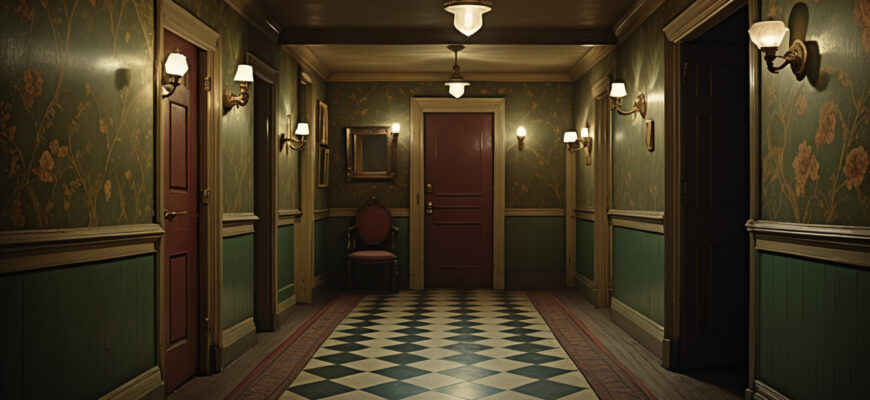Dreams about hallways carry a vivid energy, tapping into those moments when life feels like it’s paused quietly between one chapter closing and another waiting to unfold. They don’t just show you a corridor, but a rich emotional space where past choices mingle with future possibilities. Have you ever woken from a hallway dream feeling pulled between hope and worry, or like you were standing on a threshold but couldn’t yet see the whole path? Those dreams hold parts of your story about transition, about what’s being left behind and what’s ready to bloom. Whether the hallway in your dream felt tight and shadowy, or wide and hopeful, it’s less about the doors themselves and more about the place in between — that spot where identity shifts, feelings swirl, and the edges of your becoming remain mysterious.
- The Symbolism Of Hallway Dreams
- Variations In Hallway Imagery And Their Meanings
- How Hallways Reflect Personal, Spiritual, And Social Transitions
- Sitting With Uncertainty: The Power Of The In-Between
- Seeing Hallway Dreams Through a Queer and Feminist Lens
- Deconstructing Traditional Narratives Around Transition
- Affirming Queer Experiences of Becoming
- Feminist Perspectives on Power and Vulnerability in Transition
- Trauma-Informed Reflections on Hallway Dreams
- The Hallway as a Safe Space to Witness Inner Shadows
- Integration and Transformation as Healing Processes
- Practical Approaches to Engaging with Trauma-Informed Dream Work
The Symbolism Of Hallway Dreams
At their core, hallways in dreams symbolize more than just physical passageways. They invite reflection on the liminal spaces where uncertainty lives — the stretch of time and feeling between past selves and the future self you’re stepping toward. Imagine standing in a hallway, not quite able to turn back, yet not fully stepping forward either. That’s what living through transition feels like in the psyche: a holding pattern filled with both hesitation and potential.
This liminal zone represents the emotional landscape of choice. Unlike a clear room with a single purpose, hallways remind us: sometimes the options aren’t obvious, and the way forward might be cloaked in shadows or light. This in-between space stirs reflection on how change often demands patience even while stirring anxiety. It highlights that the journey matters as much as the destination.
Variations In Hallway Imagery And Their Meanings
Not all hallways dreamt about are created equal — and the details can shift the message your subconscious sends:
- Tight, dark corridors often echo feelings of fear or anxiety. They can symbolize obstacles or inner struggles, where the unknown feels heavy and movement is constricted. These passages might reflect times when the self feels vulnerable or overwhelmed by the weight of what’s next.
- Wide, sunlit passages, on the other hand, hint at clarity and possibility. They suggest openness in the journey ahead, where hope and insight light the way and new roles or identities start to feel reachable.
| Hallway Imagery | Emotional Tone | Potential Meaning |
|---|---|---|
| Tight and dimly lit | Fear, anxiety, hesitation | Inner conflicts or fear of the unknown |
| Wide and sunlit | Clarity, hope, spaciousness | New opportunities, personal growth |
| Long, winding path | Patience, endurance | Extended transition or slow transformation |
| Doors lining the walls | Choices, possibilities | Multiple options or directions ahead |
How Hallways Reflect Personal, Spiritual, And Social Transitions
Hallways can feel like more than just internal spaces—they mirror the shifts happening across personal, spiritual, and social layers. Moving through that corridor in your dream might correspond to identity shifts, new roles you’re stepping into, or healing that’s quietly unfolding.
Think of those moments when life asks for something different—maybe embracing a new sexuality, stepping into leadership, or recovering from trauma. The hallway becomes a metaphor for that passage, the sacred ground where the old self slowly fades and the new self is invited forward. It’s not a linear march but a journey full of turns, pauses, and sometimes circles. The dream gestures to the complexity of transformation, inviting gentleness with yourself.
The path from who you were to who you’re becoming isn’t always obvious or comfortable. Hallway dreams remind us that transition is a process where both letting go and stepping closer to your own truth are unfolding simultaneously.
Sitting With Uncertainty: The Power Of The In-Between
What if the tension of not knowing—of standing between rooms—actually holds its own kind of power? The place that feels uncertain or suspended isn’t just a waiting room; it’s fertile ground for change. In both life and dreams, this liminal zone is that sacred pause where transformation quietly forms.
Rather than rushing to “solve” the unknown, these moments invite you to sit with discomfort as part of growth. The unease that comes with not yet seeing the whole path is uncomfortable but necessary. It calls for patience—a gentle acknowledgment that changing shape often takes time, and that the waiting itself is active.
Hallway dreams often catch us in the middle of choice, but sometimes the pathway isn’t fully lit ahead. Recognizing this invites a kind of agency: even if the ending isn’t clear, you can start to engage actively with your own transformation. This might look like:
- Pausing to reflect without pressure
- Trusting your intuition when options aren’t visible
- Opening to change slowly at your own pace
Cultivating patience with the in-between moments means letting go of the need to rush or “fix” transition. Techniques like mindful breathing, journaling, or simply honoring your feelings as they arise can help hold space for this powerful threshold. The hallway in your dream invites you to rest here, trusting that the path is unfolding even if you can’t see it all just yet.
Seeing Hallway Dreams Through a Queer and Feminist Lens
Ever wonder what those dreams of wandering down long corridors really mean, especially when they show up during times of change? Hallways in dreams aren’t just physical spaces—they’re powerful metaphors for the liminal, that fuzzy middle ground where identities morph and futures unfold. Seen through a queer and feminist lens, these dreams challenge the usual straight-line stories about transition and growth.
Deconstructing Traditional Narratives Around Transition
Most cultural stories about becoming—whether about gender, sexuality, or selfhood—come wrapped in heteronormative and patriarchal ideas. They expect progress to be tidy: from point A to B, fixed labels checked off neatly. But what if the journey is bumpy, fluid, and messy?
Hallway dreams invite us to question those frameworks by valuing:
- Fluidity: Identity isn’t about locking into one rigid category; it’s a dance with shifting feelings and selves.
- Multiplicity: Many hallways, many doors—there’s not just one path or one truth but a constellation of possibilities.
- Non-linearity: Transitions loop, double back, pause—progress doesn’t have to be a straight line.
Affirming Queer Experiences of Becoming
For queer folks, hallways in dreams can reflect the non-binary nature of identity journeys. Think of a hallway as a stretch of in-between space where you’re neither fully here nor there, suspended in possibility. The metaphor holds the tension of liminality without demanding closure.
Instead of forcing fixed labels, these dreams embrace ambiguity and invite:
—Showing up as who you are in that moment, however undefined.
—Resisting the pressure to explain or justify identity to yourself or others.
—Honoring each step in becoming, even if it feels uncertain or changing.
Feminist Perspectives on Power and Vulnerability in Transition
Transition isn’t just personal; it’s political. Holding space in a hallway dream reflects the delicate act of sitting with uncertainty without rushing to certainty. This is where power and vulnerability meet.
There’s a political act in:
- Welcoming the unknown, not as a failure but as fertile ground.
- Allowing transformation to unfold at its own pace, especially when healing intergenerational wounds that feminism helps bring to light.
- Creating community and consciousness that supports each other through the murky phases of becoming.
Embracing hallway dreams through this lens turns the liminal into sacred terrain—where queer identities are honored and feminist power is found in being vulnerable without apology.
Trauma-Informed Reflections on Hallway Dreams
The Hallway as a Safe Space to Witness Inner Shadows
Trauma’s mark shapes how hallways appear in dreams. These corridors often carry emotional tones reflecting unresolved wounds or attempts to find safety. A dark, twisting hallway might echo fears rooted in past pain, while a lit, open corridor can signal a fragile sense of security and hope.
Understanding your dream’s hallway means tuning into the delicate balance between fear and safety cues embedded in its walls. Sometimes, the feeling of being watched or blocked reveals the trauma’s lingering hold. Other times, the hall’s emptiness opens the door to witnessing the shadows within—inviting courageous awareness instead of avoidance.
Integration and Transformation as Healing Processes
Hallway dreams provide a kind of map to unresolved trauma narratives. They ask you to notice where the corridors loop or dead-end, signaling stuck patterns or memories waiting for reconciliation. These images aren’t just scary puzzles—they’re invitations to piece together fragmented parts of yourself.
Healing happens by:
—Recognizing when a hallway scene points to something you’re avoiding.
—Welcoming the discomfort as part of your transformation.
—Allowing the dream to guide you toward new chapters of safety and wholeness.
Practical Approaches to Engaging with Trauma-Informed Dream Work
Working with hallway dreams takes care, patience, and gentleness. To engage healthily with their messages, consider practicing:
- Grounding: Root yourself through breath or touch to feel present before exploring dream emotions.
- Journaling: Write down your dream details and feelings without judgment—this clarifies what the hallway might be revealing.
- Mindful reflection: Sit with your emotions, noticing when they surge or recede rather than pushing them away.
Importantly, honor your own timing. Healing isn’t a race. Sometimes, sharing your process with a therapist or trusted community member adds support that holds you steady in those shadowed corridors.








